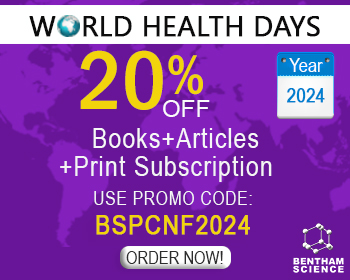Abstract
Diabetes Mellitus (DM) is an endocrine disease, which is the 3rd leading cause of death in humans; additionally, it is one of the major key concerns over the globe. The high levels of glucose in the blood stream are as well characterized by hyperglycaemia leading to serious damage to the heart, blood vessels, kidney, eyes, and nerves. The best treatment of DM is still not available; many scientists worldwide are trying hard to seek out suitable treatment of DM. Though numerous synthetic drugs are developed for the treatment of diabetes but their utility has been hampered because of several side effects and poor efficacy. Among various approaches for the treatment of DM, herbal medicine, enriched extracts, and naturally derived molecules are most effective. Plant based herbal medicines contain many bioactive phytochemicals, such as terpenoids, alkaloids, flavonoids & phenolics, etc. which are used in the treatment of many diseases. The plant-derived molecules and their suitable structure modification have given many leads or drugs to the world like sesquiterpene; artemisinin and their derivatives artemether & artesunate as an antimalarial drugs. Sesquiterpenes are available in the human diet and are largely taken as components of the many folk medicines and dietary supplements. Sesquiterpenes have a wide range of biological activities, such as anti-cancer, anti-inflammatory, anti-nociceptive, immunomodulatory, antidiabetic and antimicrobial, which make them potential targets for the development of new therapeutics and their usage for medical purposes. Natural products have gained the attention of the world due to their large number of biological activities, high safety and fewer side effect. The review mainly focuses on bioactive sesquiterpenes such as β-caryophyllene, dysidine, farnesol & eremanthin, etc., a class of terpenoids that may play an important role in the treatment or prevention of this gruesome disorder like diabetes, with their underlying mechanisms for the blood-glucose-lowering property.
Keywords: Diabetes Mellitus, Natural products, Terpenoids, Sesquiterpene, Hyperglycemia, Antihyperglycemic agents.
[http://dx.doi.org/10.2337/dc14-S081] [PMID: 24357215]
[http://dx.doi.org/10.2174/1568026615666150317223112] [PMID: 25786504]
[http://dx.doi.org/10.1016/j.jtcme.2017.08.012]
[http://dx.doi.org/10.1186/s12906-015-0588-5] [PMID: 25885803]
[http://dx.doi.org/10.3923/rjmp.2012.449.455]
[http://dx.doi.org/10.1177/14746514070070010301]
[http://dx.doi.org/10.1016/S0378-8741(02)00059-4] [PMID: 12020931]
[http://dx.doi.org/10.2337/diacare.20.7.1183] [PMID: 9203460]
[http://dx.doi.org/10.1016/0002-9378(82)90349-0] [PMID: 7148898]
[PMID: 14166677]
[http://dx.doi.org/10.1111/j.1525-1497.2004.40178.x] [PMID: 15610327]
[http://dx.doi.org/10.1016/j.amjmed.2007.03.022] [PMID: 17679132]
[http://dx.doi.org/10.2337/dc08-1631] [PMID: 19131461]
[http://dx.doi.org/10.1016/j.trsl.2006.09.008] [PMID: 17383593]
[http://dx.doi.org/10.1016/j.amepre.2005.12.009] [PMID: 16627124]
[http://dx.doi.org/10.1056/NEJMoa012512] [PMID: 11832527]
[http://dx.doi.org/10.2337/dc09-1939] [PMID: 20587727]
[http://dx.doi.org/10.2337/diacare.26.2007.S5] [PMID: 12502614]
[http://dx.doi.org/10.1056/NEJM200105033441801] [PMID: 11333990]
[http://dx.doi.org/10.2337/diacare.20.4.537] [PMID: 9096977]
[http://dx.doi.org/10.1016/S0140-6736(02)08905-5] [PMID: 12086760]
[http://dx.doi.org/10.2337/diabetes.51.9.2796] [PMID: 12196473]
[http://dx.doi.org/10.2337/diacare.23.10.1563] [PMID: 11023153]
[http://dx.doi.org/10.2337/diacare.23.3.381] [PMID: 10868870]
[http://dx.doi.org/10.1056/NEJM199309303291401] [PMID: 8366922]
[http://dx.doi.org/10.1016/S0140-6736(98)07019-6] [PMID: 9742976]
[http://dx.doi.org/10.1038/414782a] [PMID: 11742409]
[http://dx.doi.org/10.1016/j.jacc.2008.09.055] [PMID: 19179216]
[http://dx.doi.org/10.1056/NEJMoa0802987] [PMID: 18539916]
[http://dx.doi.org/10.1056/NEJMoa0806470] [PMID: 18784090]
[http://dx.doi.org/10.2337/diacare.27.7.1647] [PMID: 15220241]
[http://dx.doi.org/10.1056/NEJMoa0808431] [PMID: 19092145]
[http://dx.doi.org/10.1038/sj.jhh.1001890] [PMID: 16075030]
[http://dx.doi.org/10.1056/NEJMoa0802743] [PMID: 18539917]
[http://dx.doi.org/10.1111/j.1463-1326.2007.00670.x] [PMID: 17924862]
[PMID: 19112222]
[http://dx.doi.org/10.1186/1756-0500-6-222] [PMID: 23742649]
[http://dx.doi.org/10.1016/j.jep.2012.09.050] [PMID: 23063956]
[http://dx.doi.org/10.2337/dc12-2625] [PMID: 23468086]
[http://dx.doi.org/10.2337/dc13-2656] [PMID: 24705613]
[http://dx.doi.org/10.2337/diacare.27.5.1047] [PMID: 15111519]
[http://dx.doi.org/10.1136/bmj.291.6502.1081] [PMID: 3931804]
[http://dx.doi.org/10.1111/j.1464-5491.2005.01735.x] [PMID: 16409573]
[http://dx.doi.org/10.1016/S0140-6736(09)60937-5] [PMID: 19875164]
[http://dx.doi.org/10.1016/S2221-1691(12)60032-X] [PMID: 23569923]
[http://dx.doi.org/10.1007/s00044-010-9473-4]
[http://dx.doi.org/10.1007/s11892-004-0019-3] [PMID: 15132880]
[http://dx.doi.org/10.2337/dc06-9912] [PMID: 16873813]
[http://dx.doi.org/10.1517/13543784.13.9.1091] [PMID: 15330741]
[http://dx.doi.org/10.2174/1573408052952667]
[http://dx.doi.org/10.1007/s00125-005-1705-7] [PMID: 15759106]
[http://dx.doi.org/10.1517/13543784.15.4.431] [PMID: 16548792]
[http://dx.doi.org/10.1016/j.clinthera.2004.10.014] [PMID: 15639686]
[http://dx.doi.org/10.2165/00003495-200464120-00006] [PMID: 15200348]
[http://dx.doi.org/10.2337/dc16-S003] [PMID: 26696680]
[http://dx.doi.org/10.1007/s11892-013-0369-9] [PMID: 23446780]
[http://dx.doi.org/10.2310/JIM.0b013e318197ec8b] [PMID: 19188844]
[http://dx.doi.org/10.3164/jcbn.2007001] [PMID: 18392106]
[http://dx.doi.org/10.1007/s11418-010-0406-9] [PMID: 20238178]
[http://dx.doi.org/10.1016/j.bcp.2005.10.012] [PMID: 16289393]
[http://dx.doi.org/10.3390/nu8080461] [PMID: 27527213]
[http://dx.doi.org/10.19080/OMCIJ.2018.07.555710]
[http://dx.doi.org/10.1016/j.fitote.2012.04.029] [PMID: 22579842]
[http://dx.doi.org/10.1038/nrd1657] [PMID: 15729362]
[http://dx.doi.org/10.1016/S0031-9422(00)00456-8] [PMID: 11243450]
[http://dx.doi.org/10.3164/jcbn.40.163] [PMID: 18398493]
[PMID: 11993894]
[http://dx.doi.org/10.1586/erc.10.12] [PMID: 20222807]
[http://dx.doi.org/10.1021/ci0200467] [PMID: 12546556]
[http://dx.doi.org/10.1016/j.cbpa.2004.04.011] [PMID: 15183325]
[http://dx.doi.org/10.1016/j.pain.2007.08.028] [PMID: 17997224]
[http://dx.doi.org/10.1111/j.1399-5448.2009.00568.x] [PMID: 19754613]
[http://dx.doi.org/10.1001/jama.288.20.2579] [PMID: 12444865]
[http://dx.doi.org/10.1016/j.fct.2010.11.012] [PMID: 21092751]
[http://dx.doi.org/10.1021/acs.jnatprod.5b00883] [PMID: 27136692]
[http://dx.doi.org/10.1016/j.jep.2007.10.038] [PMID: 18068921]
[http://dx.doi.org/10.19082/1832] [PMID: 26955456]
[http://dx.doi.org/10.1021/acs.jnatprod.5b01055] [PMID: 26852623]
[http://dx.doi.org/10.32474/AOICS.2018.01.000117]
[http://dx.doi.org/10.1016/j.jada.2005.12.002] [PMID: 16503231]
[http://dx.doi.org/10.1002/mas.20182] [PMID: 18636545]
[http://dx.doi.org/10.1016/S0065-7743(08)61100-8]
[http://dx.doi.org/10.1093/nar/25.17.3389] [PMID: 9254694]
[http://dx.doi.org/10.1111/bjd.15896] [PMID: 28832953]
[http://dx.doi.org/10.9734/BJPR/2015/16293]
[http://dx.doi.org/10.1016/j.fct.2009.07.038] [PMID: 19660513]
[http://dx.doi.org/10.1211/jpp.59.12.0005] [PMID: 18053325]
[http://dx.doi.org/10.9734/BJPR/2014/8382]
[http://dx.doi.org/10.3390/molecules13051189] [PMID: 18560337]
[http://dx.doi.org/10.1055/s-2007-981577] [PMID: 17694473]
[http://dx.doi.org/10.1248/bpb.22.1137] [PMID: 10549873]
[http://dx.doi.org/10.1016/S0014-2999(98)00139-3] [PMID: 9617755]
[http://dx.doi.org/10.1055/s-2006-958124] [PMID: 7480198]
[http://dx.doi.org/10.1055/s-2006-959468] [PMID: 8073092]
[http://dx.doi.org/10.1248/cpb.41.2129] [PMID: 8118906]
[http://dx.doi.org/10.1002/9783527609949.ch3]
[http://dx.doi.org/10.2174/1568026616666160414123343] [PMID: 27086788]
[http://dx.doi.org/10.3390/molecules16064884] [PMID: 21677602]
[http://dx.doi.org/10.1007/s00606-005-0312-x]
[http://dx.doi.org/10.1002/ffj.2034]
[http://dx.doi.org/10.1016/S0040-4020(97)00015-X]
[http://dx.doi.org/10.1007/3-540-48146-X_2]
[http://dx.doi.org/10.2174/1568026614666141203120833] [PMID: 25478887]
[http://dx.doi.org/10.3390/molecules22010058] [PMID: 28042865]
[http://dx.doi.org/10.1155/2012/247597]
[http://dx.doi.org/10.1093/carcin/12.1.151] [PMID: 1988176]
[http://dx.doi.org/10.1111/j.1574-6968.2004.tb09714.x] [PMID: 15321680]
[http://dx.doi.org/10.1111/j.1349-7006.2011.02082.x] [PMID: 21883695]
[http://dx.doi.org/10.3390/ijms20122926] [PMID: 31208018]
[http://dx.doi.org/10.3390/molecules23123334] [PMID: 30558294]
[http://dx.doi.org/10.1038/aps.2009.5] [PMID: 19262557]
[http://dx.doi.org/10.1016/j.acthis.2014.10.001] [PMID: 25457874]
[http://dx.doi.org/10.1016/j.ejps.2012.05.009] [PMID: 22659375]
[http://dx.doi.org/10.1055/s-2006-960870] [PMID: 10630129]
[http://dx.doi.org/10.1021/np990023v] [PMID: 10479309]
[http://dx.doi.org/10.1007/s10068-016-0182-8] [PMID: 30263386]
[http://dx.doi.org/10.1016/j.ejps.2012.09.008] [PMID: 23022518]
[http://dx.doi.org/10.2478/acph-2020-0019] [PMID: 31955145]
[http://dx.doi.org/10.1016/B978-0-12-809450-1.00006-5]
[http://dx.doi.org/10.1016/j.fitote.2012.09.007] [PMID: 22986291]
[http://dx.doi.org/10.1007/s43450-020-00029-1]



























